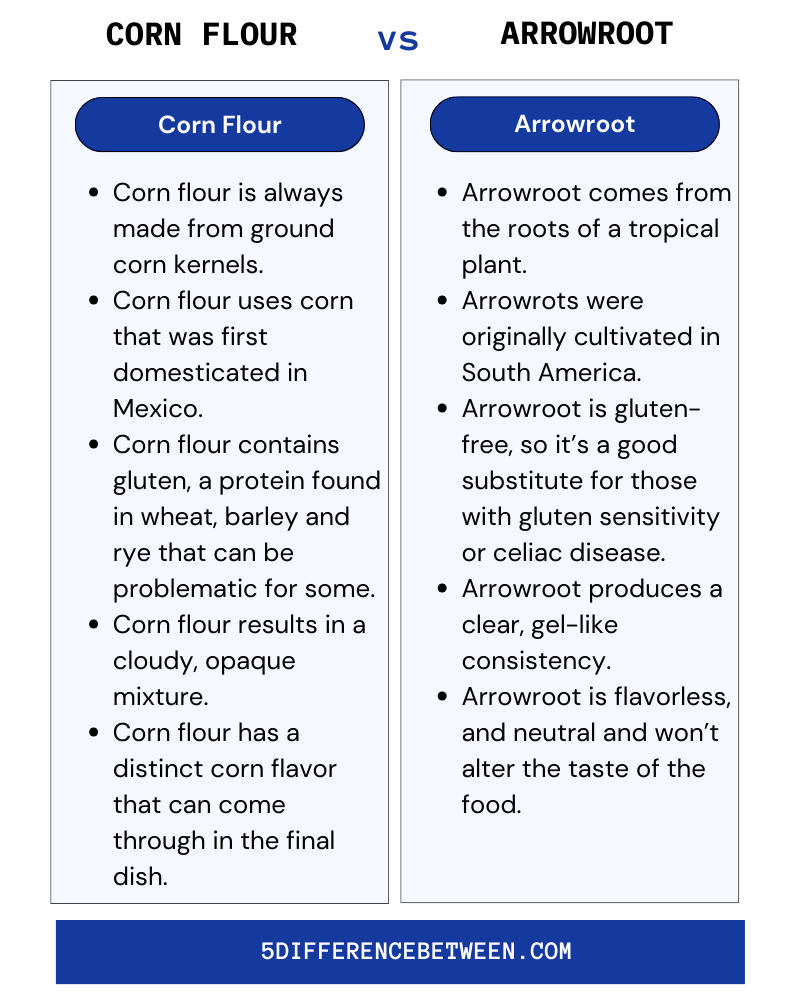Corn flour and arrowroot are both starchy thickeners used in cooking and baking, but there are a few key differences you should know. Corn flour and arrowroot come from very different places. Corn flour is made from corn, specifically corn kernels that have been dried and ground into a fine powder. Arrowroot comes from the roots of a tropical plant called Maranta arundinacea.
Origins – Where Do Corn Flour and Arrowroot Come From?
Arrowroot has been cultivated for centuries in Central America and parts of Asia and Africa. The roots are dried and ground to produce the fine, white arrowroot powder. Arrowroot was once so valuable, it was actually used as currency on some Caribbean islands.
Corn, on the other hand, originates from Mexico and Central America. Dried corn kernels are ground to produce corn flour or cornstarch. Corn flour comes in yellow and white varieties depending on the type of corn used.
Also Read > Difference Between Mocha and Cappuccino
While they share some similar properties and uses, corn flour and arrowroot have distinct origins, flavors, and nutritional profiles. Arrowroot is gluten-free, while most corn flour contains gluten. Arrowrots also have twice the starch and fewer calories than corn flour.
When it comes to cooking and baking, you can often substitute corn flour and arrowroot for one another. However, arrowroot will provide a clearer gel and a silkier texture. Corn flour has a slight yellow tint and will impart a faint corn flavor. For the most authentic results, use the ingredients specified in the recipe.
Knowing the source and attributes of your ingredients leads to better results in the kitchen. Now you can decide when to use corn flour or arrowroot – and feel good about the choice!
Uses – How Are Corn Flour and Arrowroot Used in Cooking and Baking
Cooking and baking are where you’ll notice the biggest differences between corn flour and arrowroot. Corn flour may become thin or grainy when reheated or frozen. For recipes that require freezing or extended cooking, arrowroot is the superior choice.
Arrowroot is a fantastic thickener for sauces, stews, and fruit fillings. Since it has no flavor of its own, it allows the natural flavors of the food to shine through. Arrowroot also produces a clear, glossy sauce. To use, make a slurry of arrowroot and cold water, then whisk it into the simmering liquid. Simmer for a minute while stirring to activate the thickening power.
Corn flour, on the other hand, will add a slight corn flavor to whatever you’re making. It’s often used as a coating for frying, to make corn tortillas or cornbread or as a thickener for chowders and gumbos. Corn flour produces an opaque, matte sauce. For frying, just coat meat, fish or veggies in corn flour and pan-fry as usual. To thicken with corn flour, whisk a few tablespoons into a little cold water to make a slurry, then whisk into the simmering liquid.
So in summary, use arrowroot when you want an undetectable thickener for a clear, glossy sauce. Turn to corn flour when you want to add a subtle corn flavor, or when frying or making cornbread. With a little experimenting in your kitchen, you’ll be a pro at using these versatile starches in no time!
Corn Flour vs Arrowroot

Corn Flour
- Corn flour is always made from ground corn kernels.
- Corn flour uses corn that was first domesticated in Mexico.
- Corn flour contains gluten, a protein found in wheat, barley and rye that can be problematic for some.
- Corn flour results in a cloudy, opaque mixture.
- Corn flour has a distinct corn flavor that can come through in the final dish.
Arrowroot
- Arrowroot comes from the roots of a tropical plant.
- Arrowrots were originally cultivated in South America.
- Arrowroot is gluten-free, so it’s a good substitute for those with gluten sensitivity or celiac disease.
- Arrowroot produces a clear, gel-like consistency.
- Arrowroot is flavorless, and neutral and won’t alter the taste of the food.
In summary, while corn flour and arrowroot can often be used interchangeably as thickeners, there are some key differences to consider based on your needs and recipe requirements. When in doubt, you can also experiment by substituting one for the other to see which texture and flavor you prefer.






